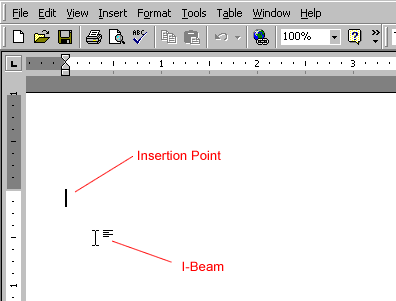Lesson 2: Using the Insertion Point
/en/word2000/word-window-new-open-and-change-view/content/
Introduction
By the end of this lesson, you should be able to:
The insertion point
The insertion point—also called a cursor—is the blinking line in your document that indicates where text is inserted when you type. There are several ways to move an insertion point.
The I-beam shows where your mouse pointer is. The blinking insertion point shows where your next word will be once you start typing.
When you are in a Word document, your pointer changes from an arrow ( ) to an I-beam (
) to an I-beam ( ).
).
Once the pointer leaves the Word document to perform a Windows function, it changes back into an arrow (  ).
).
Notice the line that indicates the end of your document. You cannot move your insertion point below this line.

Moving the insertion point
To move the insertion point:
- Use your mouse to move your insertion point anywhere within the document. Move your mouse until the I-beam is where you want your insertion point to be and click.
OR - Use your arrow keys to move your insertion point up, down, left, or right. These movements move your insertion point one space or line at a time. This method is especially useful if you only need to move a few spaces or lines back in a document to make a correction.
OR - Hold the Control key and press the up or down arrow keys to jump up or down a paragraph at a time.
OR - Press Page Down (PgDn) to jump down the document one window at a time.
Challenge!
- Notice the insertion point at the beginning of the document.
- Using the methods described in this lesson, test the insertion point's ability to move.
/en/word2000/selecting-text/content/


![]() ) to an I-beam (
) to an I-beam (![]() ).
).![]() ).
).